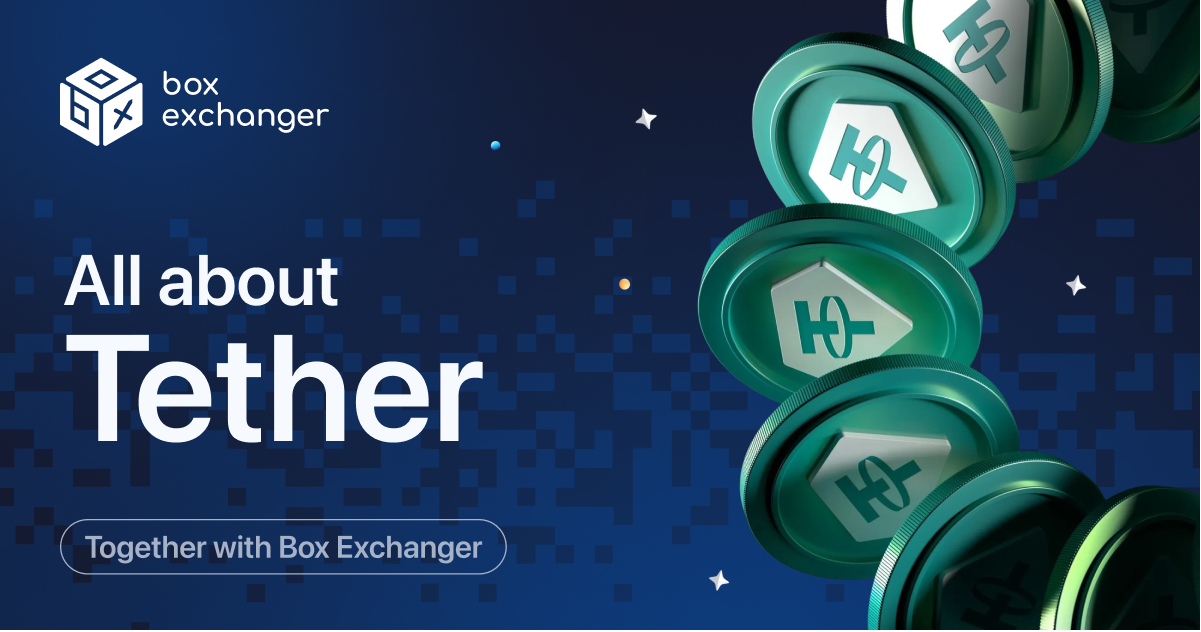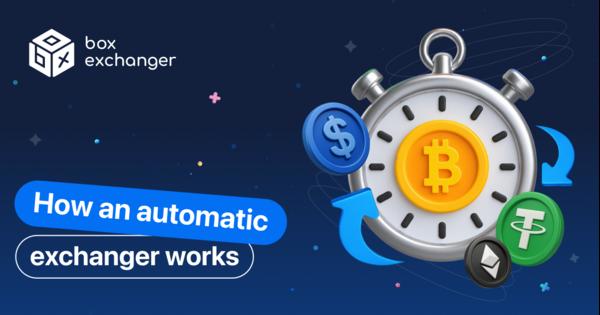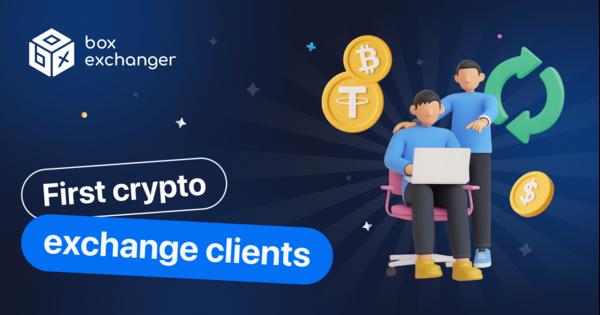6 min.
All about Tether
Added: November 21, 2025

When an online exchange owner wants to understand everything about Tether, it's not just about the exchange rate, but also about the risks, liquidity, and role of stablecoins in business. According to CoinMarketCap and Coinlaw analysts, USDT's market capitalisation in 2025 will exceed $180 billion, and the token's share in stablecoin turnover will remain dominant.
This is a key asset for the BoxExchanger service: customers often choose tether usdt for deposits and withdrawals, and the exchange receives a steady stream of requests and a clear dollar ‘unit of account’.
The history of Tether's creation and development
The modern history of Tether began in 2014, when a team of developers launched a stablecoin based on the Omni protocol on top of the Bitcoin blockchain. At that time, the project was called Realcoin, but later became known as Tether.
The turning point came when the token was connected to the Bitfinex exchange: pairs with USDT gave the market a convenient way to quickly move from volatile assets to the ‘digital dollar’ and back. Within a few years, the daily turnover of the stablecoin surpassed Bitcoin, and the token itself became one of the three largest cryptocurrencies by capitalisation.
Today, any brief overview of Tether describes an entire ecosystem: in addition to the dollar-pegged stablecoin, there are pegs to the euro, gold and other assets, and the company itself invests its profits in US Treasury bonds, mining and AI projects. The company publishes regular reports on its reserves. Analytics from Macromicro and other resources show that a significant portion of the portfolio does indeed consist of short-term US bonds and money in bank accounts.
For the average user, USDT is a digital dollar that:
• is stored on the blockchain in the form of tokens;
• is transferred between wallets in minutes;
• fixes the value of the portfolio without going through the banking system;
• serves as collateral and a unit of account in DeFi protocols.
This model is also important for BoxExchanger owners: USDT reserves are based on the quality and transparency of the Tether Limited portfolio, as well as the stability of the US debt market.
On which blockchains is Tether issued?
Initially, tokens were only issued on the Bitcoin network, but now Tether supports a whole range of chains: Ethereum, Tron, Solana, Polygon, Avalanche and others. The project's official website and Coinlaw analytics note that most of the turnover is accounted for by Ethereum and Tron.
The ERC-20 and TRC-20 standards have become the de facto industry standard for USDT transfers:
• ERC-20-USDT is convenient to use in the DeFi ecosystem when working with large amounts and institutional counterparties;
• TRC-20-USDT attracts customers with low fees and high transaction speeds, which is why exchange customers often choose this network.
When configuring the BoxExchanger script, it makes sense to distribute reserves across multiple networks. This approach reduces commission costs and gives customers a choice, which is especially important for international transfers.
Tether Application
Tether cryptocurrency has become a universal tool for those who fix profits, transfer money between exchanges, or pay for services in cryptocurrency. According to Coinlaw estimates, in 2025, USDT will control more than 80% of stablecoin trading turnover and about 8% of the total cryptocurrency market capitalisation.
USDT is used in several key scenarios:
• trading pairs on centralised exchanges and P2P platforms;
• payments for services and goods, especially in the international sphere;
• cross-border transfers for freelancers and businesses;
• collateral in credit protocols and liquidity pools;
• base asset for online exchangers.
USDT is useful because customers think in dollars. People see a clear amount, quickly compare it with the bank rate, and understand the benefits of the exchange. If a project wants to know everything about stablecoins, it is precisely these everyday scenarios that play a decisive role: convenience and speed are more important than the intricacies of the internal structure of reserves.
In this operational logic, tether usdt becomes the ‘workhorse’ of the exchange: requests with it come in regularly, and commissions on Tron or other L2 solutions remain comfortable for retail customers.
The difference between Tether and other stablecoins
The stablecoin market is broadly divided into four groups: fiat-backed, commodity-backed (e.g., gold-backed), crypto-collateralised, and algorithmic. Research on stablecoins published on platforms such as Gate and Binance's analytical blogs shows that fiat-backed solutions dominate in terms of transaction volume.
This category includes USDT and USDC: both projects hold reserves in bonds, cash, and other traditional assets. DAI and similar tokens rely on cryptocurrency collateral, while algorithmic experiments, such as projects that have already collapsed, are heavily dependent on market dynamics and exchange rate maintenance mechanisms.
Against this backdrop, the tether stablecoin stands out for its combination of enormous liquidity and wide availability. It is integrated into almost all major exchanges and payment gateways, making it the most convenient choice for exchangers and traders.
Advantages and disadvantages of Tether
For businesses building exchange services, the advantages of USDT are obvious:
• deep liquidity and high daily turnover, often exceeding that of Bitcoin and Ethereum;
• developed infrastructure: many wallets, payment aggregators, and banking partners support USDT;
• availability on different blockchain networks and the ability to choose based on fees and speed;
• regular reserve reports confirming that a significant portion of the portfolio is in short-term US bonds and cash equivalents.
There are also disadvantages that are important to consider in risk management:
• Tether remains a centralised issuer. The company is controlled by specific owners, interacts with regulators, and is able to block individual addresses at the request of law enforcement agencies.
• The volume of investments in US Treasury bills is comparable to the portfolios of entire countries, so the stability of the stablecoin partly depends on the situation in the debt market. Research by Ante and materials from Binance estimate Tether's share of the treasury bill market at approximately 1.6–2%.
Therefore, a reasonable approach for an exchange is to diversify its reserves: part of the capital in USDT, part in other stablecoins and base cryptocurrencies.
The future of Tether and its impact on the cryptocurrency market
Reports from international organisations and business press materials show that the stablecoin market is growing at an explosive rate: from several billion dollars a few years ago to hundreds of billions in 2025, with forecasts pointing to a possible trillion-dollar market by the end of the decade.
Against this backdrop, Tether USDT appears to be a key infrastructure element:
• The token serves as the basis for settlements between exchanges, market makers and payment systems.
• Tether invests its profits in AI startups, mining and other technological areas, expanding its influence beyond the crypto market;
• regulators are tightening requirements for reporting and reserve management, which increases transparency and reduces the likelihood of sharp shocks to the market.
For exchange owners, the future of Tether means steady demand for USDT-based transactions and a gradual shift of some international payments to stablecoins. Those who need to know everything about stablecoins see them not only as a trading instrument, but also as the foundation of the future payment infrastructure.
Conclusion
Tether has formed a new layer of the financial system, where digital dollars are transferred via blockchain as easily as messages in a messenger app. With competent reserve management, risk assessment, and monitoring of the issuer's reports, Tether cryptocurrency helps expand the customer base, strengthen trust in the exchange, and build a sustainable business in the field of digital assets.
The information presented in this article is for informational purposes only and does not constitute a guide to action, financial advice or investment advice. Cryptocurrency investments involve a high level of risk, and each investor should conduct their own analysis, assess their financial capabilities and consult with professional financial advisors before making investment decisions.
Frequently Asked Questions
How does USDT differ from a regular bank deposit in dollars?
USDT exists on the blockchain: tokens are stored at addresses, transferred between wallets and exchanges, and collateral is formed from a portfolio of bonds and cash equivalents, rather than a separate account belonging to a specific customer.
Can Tether be considered a completely reliable asset?
Stablecoin shows a stable peg to the dollar and regularly publishes reserve reports, but it depends on the quality of asset management and regulation in the jurisdictions where bonds and bank accounts are located. Therefore, investors often distribute funds between several stablecoins and base cryptocurrencies.
Is it worth adding USDT to every online exchange?
Most traders and retail users are accustomed to working with this particular stablecoin, and USDT trading volumes exceed those of many other assets. Therefore, connecting USDT routes usually increases the attractiveness of the exchange and the turnover of orders.
Also read

October 26, 2025
How an Automatic Exchanger Works
How an automatic exchanger works — in short: the user selects the exchange direction, the system locks the rate, ac...

October 25, 2025
Exchange Service Monitoring
The market for exchanging digital and fiat assets is huge and dynamic: the total daily trading volume of the crypto...

October 20, 2025
How to attract your first customers to a crypto exchange
Are you launching a new service and wondering how to attract your first customers to a crypto exchange quickly and ...